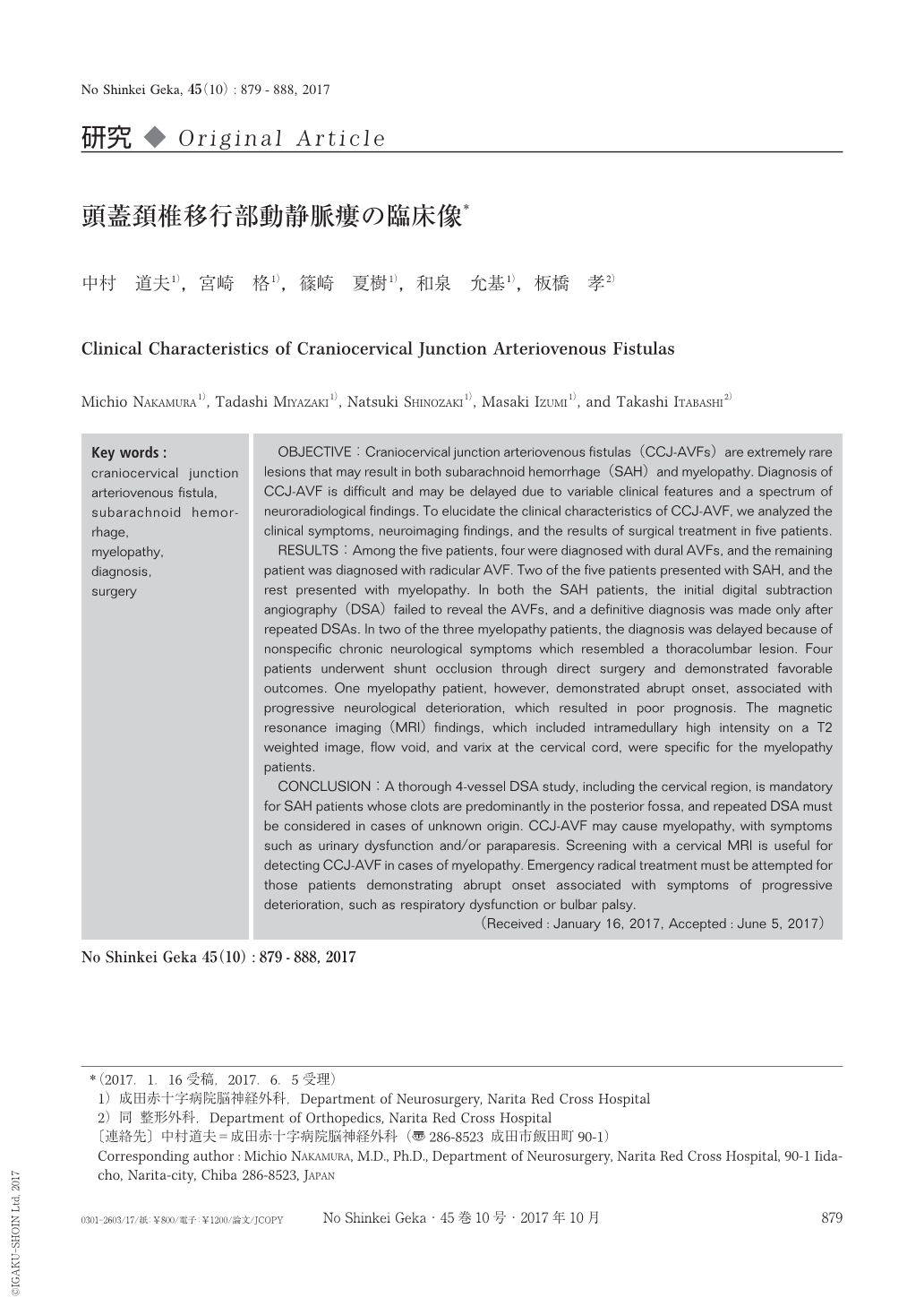Japanese
English
- 有料閲覧
- Abstract 文献概要
- 1ページ目 Look Inside
- 参考文献 Reference
Ⅰ.はじめに
頭蓋頚椎移行部動静脈瘻(craniocervical junction arteriovenous fistula:CCJ-AVF)は極めて稀な疾患で,代表疾患であるdural AVF(DAVF)においても,頭蓋内および脊髄硬膜動静脈瘻全体の約3.3%と報告されている27).発症様式はくも膜下出血(subarachnoid hemorrhage:SAH)と脊髄症状が約1:1とされるが14,21),病変部位が頭蓋内と脊髄の境界領域であり,その希少さも相まってどちらの発症様式をとっても診断に苦慮する可能性がある2,3,7,32,33).今回われわれは,当院で経験したCCJ-AVF症例の臨床像から特に診断困難の要因について検討し,文献的な考察を加えて報告する.
OBJECTIVE:Craniocervical junction arteriovenous fistulas(CCJ-AVFs)are extremely rare lesions that may result in both subarachnoid hemorrhage(SAH)and myelopathy. Diagnosis of CCJ-AVF is difficult and may be delayed due to variable clinical features and a spectrum of neuroradiological findings. To elucidate the clinical characteristics of CCJ-AVF, we analyzed the clinical symptoms, neuroimaging findings, and the results of surgical treatment in five patients.
RESULTS:Among the five patients, four were diagnosed with dural AVFs, and the remaining patient was diagnosed with radicular AVF. Two of the five patients presented with SAH, and the rest presented with myelopathy. In both the SAH patients, the initial digital subtraction angiography(DSA)failed to reveal the AVFs, and a definitive diagnosis was made only after repeated DSAs. In two of the three myelopathy patients, the diagnosis was delayed because of nonspecific chronic neurological symptoms which resembled a thoracolumbar lesion. Four patients underwent shunt occlusion through direct surgery and demonstrated favorable outcomes. One myelopathy patient, however, demonstrated abrupt onset, associated with progressive neurological deterioration, which resulted in poor prognosis. The magnetic resonance imaging(MRI)findings, which included intramedullary high intensity on a T2 weighted image, flow void, and varix at the cervical cord, were specific for the myelopathy patients.
CONCLUSION:A thorough 4-vessel DSA study, including the cervical region, is mandatory for SAH patients whose clots are predominantly in the posterior fossa, and repeated DSA must be considered in cases of unknown origin. CCJ-AVF may cause myelopathy, with symptoms such as urinary dysfunction and/or paraparesis. Screening with a cervical MRI is useful for detecting CCJ-AVF in cases of myelopathy. Emergency radical treatment must be attempted for those patients demonstrating abrupt onset associated with symptoms of progressive deterioration, such as respiratory dysfunction or bulbar palsy.

Copyright © 2017, Igaku-Shoin Ltd. All rights reserved.


